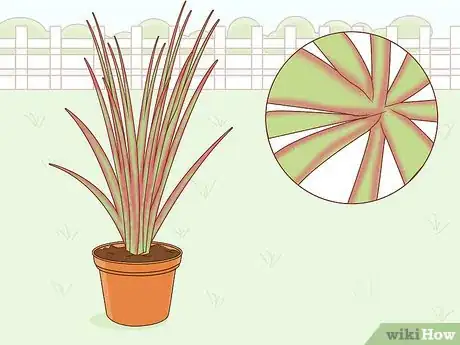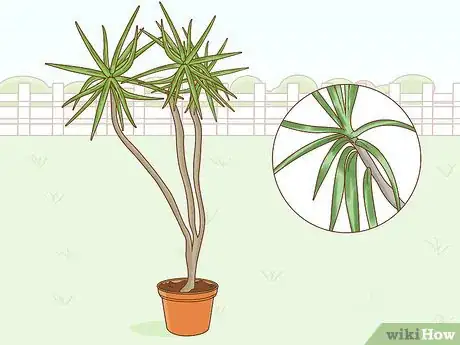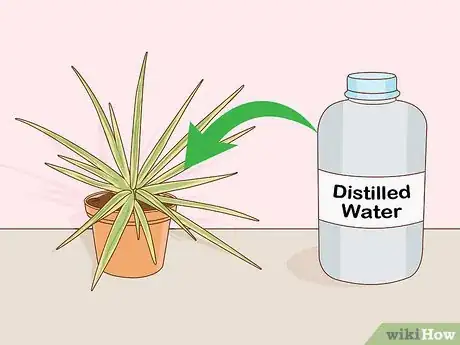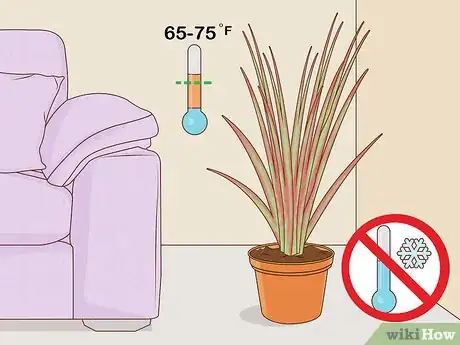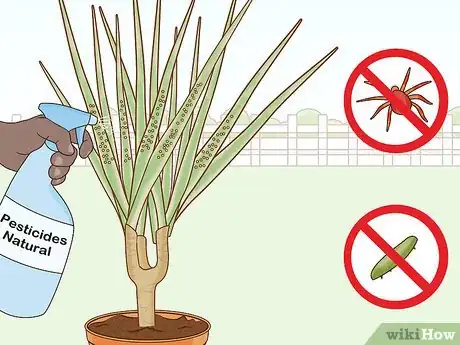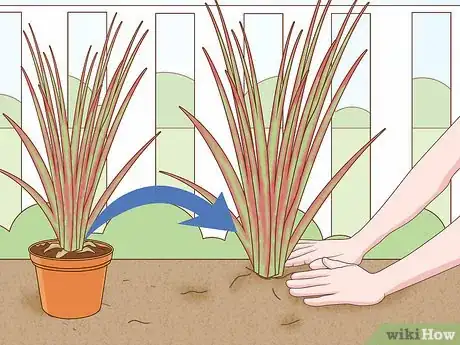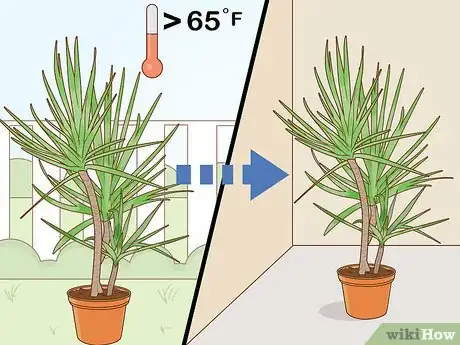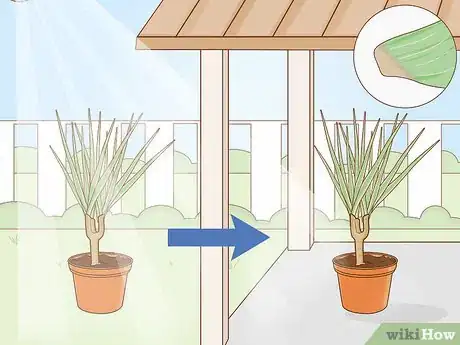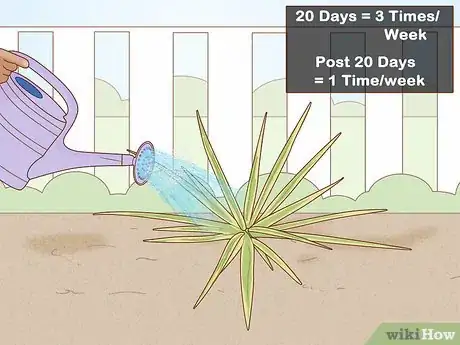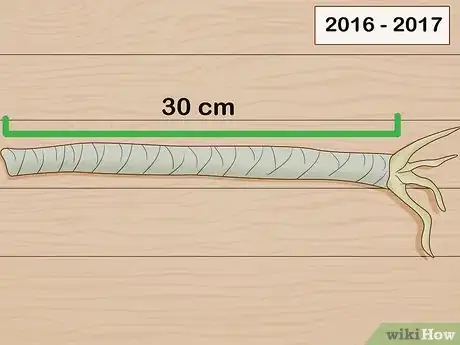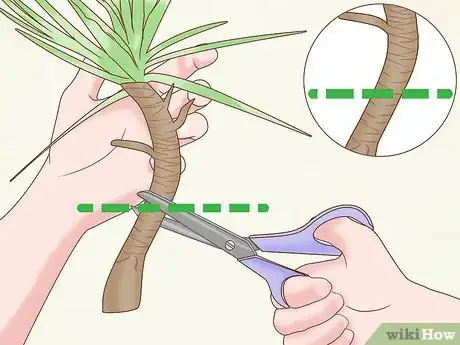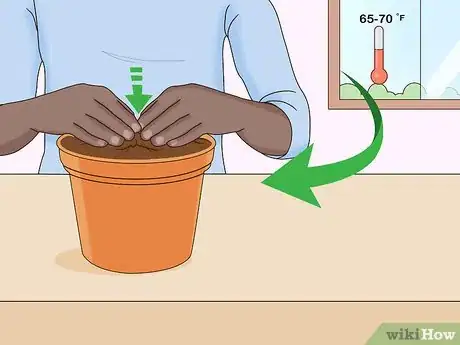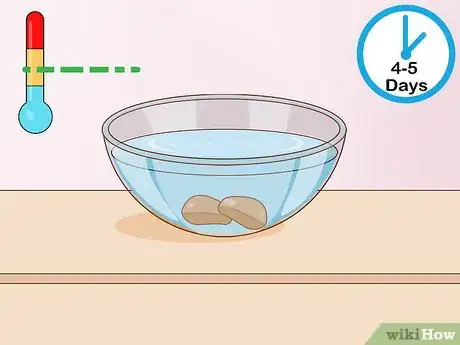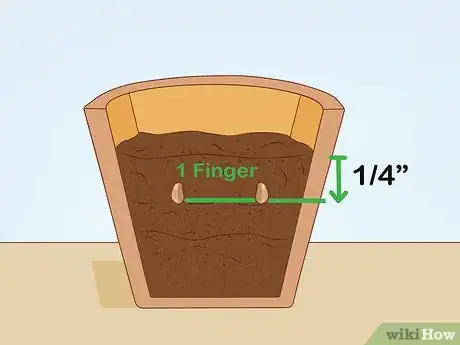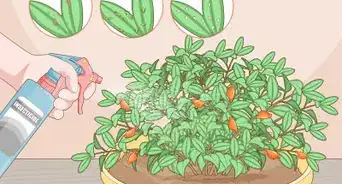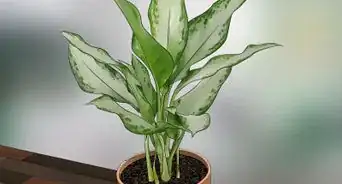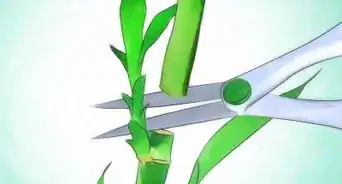This article was co-authored by Lauren Kurtz. Lauren Kurtz is a Naturalist and Horticultural Specialist. Lauren has worked for Aurora, Colorado managing the Water-Wise Garden at Aurora Municipal Center for the Water Conservation Department. She earned a BA in Environmental and Sustainability Studies from Western Michigan University in 2014.
There are 20 references cited in this article, which can be found at the bottom of the page.
wikiHow marks an article as reader-approved once it receives enough positive feedback. This article received 13 testimonials and 94% of readers who voted found it helpful, earning it our reader-approved status.
This article has been viewed 339,459 times.
The Madagascar dragon tree, or Dracaena marginata, is a reliable and low-maintenance indoor plant. If you live in a warm area with extremely mild winters, you can also keep this colorful tree outdoors all year! Be sure to provide the plant with a mixture of sun and shade, as well as enough (but not too much!) water. You can propagate these plants from cuttings, or from seeds if you prefer a challenge. And if you love cheerful colors like red and yellow, choose a different Dracaena marginata cultivar to brighten up your home or garden.
Steps
Choosing a Madagascar Dragon Tree
-
1Pick the Dracaena marginata for the original variety. This is the plant that all the other options (called “cultivars”) were cultivated from. It has a narrow reddish purple band around the edges of its green leaves.[1]
-
2Choose the marginata tricolor cultivar for a greenish gold plant. This plant has a yellowish white band on its leaves that separate the red from the green. It may even appear white or yellow from a distance.[2]Advertisement
-
3Go for the marginata colorama cultivar for a reddish look. This is perhaps the most unique-looking of the cultivars. Its outer red band is very prominent, leading it to appear red or pink.[3]
-
4Grow the marginata Tarzan cultivar for spikier leaves. This tree has the same color pattern as the original marginata, but its leaves are a bit different. The stems will produce growths that have wider and tougher leaf patterns than the other trees. Groups of leaves grow in dense sphere shapes.[4]
Caring for an Indoor Madagascar Dragon Tree
-
1Pick a spot that provides bright but indirect light. Placing the tree in full sun might cause the leaves to burn. To avoid this problem, put the plant in front of a north-facing window and near either a west- or-east-facing window. Your tree shouldn’t be too close to a south-facing window.[5]
- If the colors on the leaves begin to fade, your plant isn’t getting quite enough light. If this happens, move it in front of the east- or west-facing window and keep an eye on the leaves. Burnt leaves will appear brown and dry on the tips.[6]
-
2Use well-draining potting soil in a container with drainage holes. While this tree appreciates moisture, it can develop root rot if the soil becomes too wet. Fill a houseplant container that’s double the size of your root ball halfway with potting soil that drains well. Center the tree in the container, then fill the rest of the pot with the soil. Use distilled water to thoroughly moisten the roots.[7]
- You may have bought your plant in a container from the nursery. You can leave it in there until it’s ready to be repotted!
-
3Water only once the top of the soil has dried out. Stick your finger in the soil. If the surface and several inches (or centimeters) of soil feel dry to the touch, water the plant with distilled water until the soil completely re-moistens. Keep an eye on the soil to prepare for the plant’s next watering.[8]
- Luckily, the leaves will tell you if you’re over or underwatering! If the leaves are falling off and turning yellow, you probably need more water. If they’re only yellowing at the tips, it’s more likely that you’re overwatering.
- When the leaves towards the bottom of the shoots brown or fall off, this is natural. It’s just the old leaves making way for new ones!
-
4Keep the temperature around 75 °F (24 °C) except during winter. If you prefer to keep your home warmer, these trees will also thrive in indoor temperatures up to about 80 °F (27 °C).[9] When the weather begins to cool down outside, reduce the temperature in your home or the plant’s room by a few degrees.[10] This will give it a rest period. Don’t dip the temperature below 65 °F (18 °C), however.[11]
-
5Mist the leaves regularly to reduce pests. The Madagascar dragon tree is prone to a few different insect infestations, including the glasshouse red spider mite, thrips, and scale insects.[12] If you keep the air around the tree moist with misting at least 1-2 times per week, you may prevent these outbreaks.[13] However, if you see mottled leaves or yellowish bumps on the undersides of the leaves, your tree is probably infested.[14]
- Talk to your local nursery or go online to purchase a pesticide appropriate for the outbreak.
- You may also be able to use natural pesticides, although these options may not be as effective with advanced infestations.
-
6Use houseplant fertilizer once per month except during winter. During the spring and summer, you can encourage growth with standard fertilizer meant for houseplants. Choose a water-soluble fertilizer that can be diluted to 50% strength. Stop fertilizing during the autumn and winter to give the tree a rest period.[15]
- Follow the instructions on your fertilizer’s packaging for the precise amount you should use on the plant. Expect to create a 1-part water and 1-part fertilizer solution.
-
7Prune in spring or summer to make the plant more dense. Use sharp and clean garden shears to prune the tree if it develops weak off-shoots or stems. This will keep your plant from developing longer, drooping stems. Clip the growth at an angle right at the base of the stem.[16]
- Don’t prune in the late summer, fall, or winter. You want to give the plant some time to develop new growth before it begins to rest.
- Keep these cuttings to plant new trees!
-
8Repot your tree if the roots become crowded. Periodically check the drainage holes at the bottom of your container. If the roots grow out of the holes, it’s time to repot.[17] Choose a pot that’s 2 inches (5.1 cm) wider and deeper than the old one. Turn the current pot on its side to gently ease the tree out. Snip the ends off the roots to stimulate growth in the new pot.[18]
- Your new pot should also have drainage holes, and you should fill it about halfway with well-draining potting soil before placing the transplanted tree inside. Then, fill the pot with more soil and moisten with distilled water.
- If the tree doesn’t want to come out, straighten the coiled roots with your fingers. You can also tap the bottom and sides of the pot gently, then reposition it on its side.
- Wait at least a month to fertilize your repotted tree.
Planting Your Madagascar Dragon Tree Outside
-
1Find out which hardiness zone you live in for outdoor growing. The United States Department of Agriculture (USDA) has produced a map with information about temperatures and growing conditions in different “zones” of the U.S.[19] The Madagascar dragon tree can only be kept outdoors all-year round in zones 10 and 11, which are located on the coast of Southern California and the tip of Southern Florida.[20]
- While this map is most useful for growers living in the U.S., other countries (such as Australia) have produced similar maps using the same temperature guidelines.[21] Go online to find information about your growing zone.
-
2Plan for an outdoor/indoor plant if your climate is cooler. If you live in zones 8 or 9, you can keep your tree outdoors during the spring and summer and bring it indoors once the temperature has dropped. Optimally, these plants prefer temperatures above 65 °F (18 °C), so pull it indoors as soon as the temperature begins to drop in early autumn.
- You may also be able to keep this plant outdoors in the warm summer months in northern USDA zones. Keep a close eye on the weather, though! If your evening temperatures drop below 60 to 65 °F (16 to 18 °C), your plant could stop growing or die.[22]
-
3Plant your tree in a partially shaded area. Your tree should get about 4-6 hours of sunlight over the course of the day. To keep it from burning up, it should have at least a few hours of shade, as well.
- Keep an eye out for leaves with dry, brown tips. This means you’re giving your plant too much sun. Yellowing leaves means it needs a bit more sunlight.[23]
-
4Choose a spot with well-draining soil. To test drainage, dig a hole in the soil and fill it completely with water. Let it drain and then fill it again. If the hole drains in under 15 minutes, your soil has good drainage. If the hole takes more than an hour (especially if it takes longer than six hours) to drain, you’ve got slow-draining soil.
- If the drainage doesn’t need to be adjusted too much, you may just be able to add some compost and well-rotted manure to improve it. For severe drainage issues, you might need to invest in underground piping to remove the excess water.[24]
-
5Dig a hole that’s twice the size of the root ball. Measure the diameter of the root ball to get the right-sized hole. Center the tree in the hole, then fill it in with soil. Pack the soil down again before using distilled water to moisten the area.[25]
- You can also keep the plant in an outdoor garden pot.[26]
-
6Water frequently for 3 weeks, then once per week. Moisten the soil surrounding the tree 2 to 3 times per week while it’s settling into its new spot. After about 20 days, reduce watering to once per week. If the soil is wet, you can water even less frequently. Wait until the spot has dried out to re-water.[27]
- If you’re experiencing extremely dry conditions, you may need to increase your watering. Look for leaves that are yellow at the tips to see if you’re overwatering. If the leaves are falling off, water the tree a bit more.
- If the leaves are only browning or yellowing and falling off at the bottom of the stems, this is just natural growth. New, healthy leaves should appear above these older ones.
Propagating with Stem Cuttings
-
1Use cuttings from a mature tree for easier propagation. You’ll likely have more success starting a Madagascar dragon tree from cuttings than seeds. The seeds can be a bit more temperamental, and they may not germinate well.[28]
- If you’re going to keep the cutting indoors, this can be done at any time of year. If you want to replicate the tree’s natural growing conditions, however, propagate in summer.[29]
-
2Choose healthy shoots that grew in the last year. Pick a stem that has a nice, full growth sprouting out at the top. It should be an established stem that didn’t just poke up from the soil.[30] It also needs to be long enough to produce a shoot. Cut a piece that’s about 20 to 30 centimetres (7.9 to 11.8 in) long.[31]
-
3Slice the bottom of the stem straight across. Leave the top still attached, as the foliage will help increase your plant's nutrient availability. Leaves allow more potential for photosynthesis to occur.[32]
-
4Place the base of the stem in a container of water. Put the side of the stem with the straight-across cut face down in about 3 to 5 inches (7.6 to 12.7 cm) of distilled water.[33] To prevent bacterial growth, change out the water every 5-7 days.[34] Ensure that it stays at the same level by topping it off in between changes if you need to.
-
5Provide a heating source and use a rooting hormone. Your heat source should come up from below your plant, such as a heat lamp. Using heat and a rooting hormone will increase the chances that your efforts are successful.
- Follow all of the directions for using your rooting hormone.
-
6Expect to see roots after a few weeks. While it might take a while for you to see new sprouts at the top of the stem, roots should start to develop after only 10-20 days. They’ll look like little white curls.[35] These rooted stems can then be transferred to individual containers filled with houseplant potting soil.[36]
Sowing Seeds
-
1Propagate by seed if you don’t have access to a mature tree. While it’s certainly possible to propagate Madagascar dragon trees from seeds, you may need to try this method a few times to get it right. It’s difficult to grow many varieties of trees from seed, and these plants are no exception. If you want a horticultural challenge, this option is for you![37]
- You can buy Madagascar dragon tree seeds online, although they may actually be more expensive than a mature plant.
-
2Sow indoors before the last frost at 64 to 70 °F (18 to 21 °C). This will replicate the plant’s natural growth cycle, helping to stimulate germination.[38]
-
3Soak the seeds for 4-5 days before sowing. Place the seeds in a bowl of warm water. You do not need to change the water each day. This, too, will encourage germination.[39]
-
4Bury the seeds in potting soil in a small pot. Fill the pot with either seed-growing compost, or an equal-parts mixture of multipurpose compost and perlite. Pack down the compost with your fingers. Use distilled water to moisten the soil until water drains out from the holes at the bottom of the container. Then, place no more than 1 or 2 seeds in the container, burying them slightly.[40]
- The seeds don’t need more than about 1⁄4 inch (0.64 cm) of covering over them.
- Seed-growing compost is better than multipurpose, but both should work.
- There should be at least a finger-width of space between the 2 seeds.
-
5Cover the pots with plastic to keep them moist. Place the container in a resealable plastic bag. Label the bag with the plant’s name and date you sowed the seeds. Check the soil every day or so to make sure it’s still moist. If it’s dried out, re-moisten it.[41]
-
6Wait 30-40 days for germination. If germination is successful, it should occur in about a month. Once the seedlings are large enough to handle, you can gently move them into their own little pots filled with moistened potting soil.[42] Continue to keep them inside until the leaves have sprouted and hardened a bit.[43]
Expert Q&A
Did you know you can get expert answers for this article?
Unlock expert answers by supporting wikiHow
-
QuestionWhat fertilizer or food should I give it?
 Lauren KurtzLauren Kurtz is a Naturalist and Horticultural Specialist. Lauren has worked for Aurora, Colorado managing the Water-Wise Garden at Aurora Municipal Center for the Water Conservation Department. She earned a BA in Environmental and Sustainability Studies from Western Michigan University in 2014.
Lauren KurtzLauren Kurtz is a Naturalist and Horticultural Specialist. Lauren has worked for Aurora, Colorado managing the Water-Wise Garden at Aurora Municipal Center for the Water Conservation Department. She earned a BA in Environmental and Sustainability Studies from Western Michigan University in 2014.
Professional Gardener You should give it a fertilizer designated for house plants. This can be in a liquid or slow release form, depending on your preference. Liquid will need to be applied more frequently. About once per month during the spring and summer, not regularly during fall and not at all during the winter. A slow release fertilizer can be used every few months. Avoid fertilizing for about two months or longer after transplanting your tree.
You should give it a fertilizer designated for house plants. This can be in a liquid or slow release form, depending on your preference. Liquid will need to be applied more frequently. About once per month during the spring and summer, not regularly during fall and not at all during the winter. A slow release fertilizer can be used every few months. Avoid fertilizing for about two months or longer after transplanting your tree. -
QuestionWhat is wrong if the leaves on my tree are suddenly turning yellow?
 Lauren KurtzLauren Kurtz is a Naturalist and Horticultural Specialist. Lauren has worked for Aurora, Colorado managing the Water-Wise Garden at Aurora Municipal Center for the Water Conservation Department. She earned a BA in Environmental and Sustainability Studies from Western Michigan University in 2014.
Lauren KurtzLauren Kurtz is a Naturalist and Horticultural Specialist. Lauren has worked for Aurora, Colorado managing the Water-Wise Garden at Aurora Municipal Center for the Water Conservation Department. She earned a BA in Environmental and Sustainability Studies from Western Michigan University in 2014.
Professional Gardener
-
QuestionWhy are leaves falling off my dragon plant?
 Community AnswerIf it is the lower leaves that are falling off, it is perfectly normal. This is to allow for new growth.
Community AnswerIf it is the lower leaves that are falling off, it is perfectly normal. This is to allow for new growth.
Warnings
- Madagascar dragon trees are very sensitive to fluoride, which is why it’s best to water them with distilled water.⧼thumbs_response⧽
- Madagascar dragon trees are poisonous to dogs and cats, so consider choosing a different for houseplant if you own an animal.[44]⧼thumbs_response⧽
References
- ↑ https://www.ourhouseplants.com/plants/dracaena-marginata
- ↑ https://www.ourhouseplants.com/plants/dracaena-marginata
- ↑ https://www.ourhouseplants.com/plants/dracaena-marginata
- ↑ https://www.ourhouseplants.com/plants/dracaena-marginata
- ↑ https://www.epicgardening.com/dracaena-marginata-madagascar-dragon-tree/
- ↑ http://www.balconycontainergardening.com/gardening/154-leaf-scorch-tip-burn
- ↑ https://www.epicgardening.com/dracaena-marginata-madagascar-dragon-tree/
- ↑ https://www.epicgardening.com/dracaena-marginata-madagascar-dragon-tree/
- ↑ https://www.epicgardening.com/dracaena-marginata-madagascar-dragon-tree/
- ↑ http://www.thegardenhelper.com/dracaena_marginata.html
- ↑ https://plantcaretoday.com/care-dracaena-marginata.html
- ↑ https://www.rhs.org.uk/Plants/31916/Dracaena-marginata-(v)/Details
- ↑ https://www.epicgardening.com/dracaena-marginata-madagascar-dragon-tree/
- ↑ https://www.rhs.org.uk/Plants/31916/Dracaena-marginata-(v)/Details
- ↑ http://tipsplants.com/plants/house-plants/dracaena
- ↑ https://www.youtube.com/watch?v=Kjoo1Js0-5A&feature=youtu.be&t=287
- ↑ http://www.guide-to-houseplants.com/dragon-tree.html
- ↑ http://www.guide-to-houseplants.com/repotting-house-plants.html
- ↑ http://planthardiness.ars.usda.gov/PHZMWeb/
- ↑ http://edis.ifas.ufl.edu/fp185
- ↑ https://www.anbg.gov.au/gardens/research/hort.research/zones.html
- ↑ http://tipsplants.com/plants/house-plants/dracaena
- ↑ http://www.balconycontainergardening.com/gardening/154-leaf-scorch-tip-burn
- ↑ http://www.bhg.com/gardening/landscaping-projects/landscape-basics/improve-poor-drainage/
- ↑ http://tipsplants.com/plants/house-plants/dracaena
- ↑ https://www.rhs.org.uk/Plants/31916/Dracaena-marginata-(v)/Details
- ↑ http://tipsplants.com/plants/house-plants/dracaena
- ↑ http://edis.ifas.ufl.edu/fp185
- ↑ https://www.rhs.org.uk/Plants/31916/Dracaena-marginata-(v)/Details
- ↑ https://www.rhs.org.uk/advice/profile?pid=387
- ↑ http://www.gardenersworld.com/how-to/grow-plants/how-to-take-stem-cuttings-from-dracaena/
- ↑ https://www.rhs.org.uk/advice/profile?pid=387
- ↑ http://www.gardenersworld.com/how-to/grow-plants/how-to-take-stem-cuttings-from-dracaena/
- ↑ https://www.joyusgarden.com/dracaena-marginata-cuttings/
- ↑ https://www.joyusgarden.com/dracaena-marginata-cuttings/
- ↑ http://www.gardenersworld.com/how-to/grow-plants/how-to-take-stem-cuttings-from-dracaena/
- ↑ https://www.motherearthnews.com/organic-gardening/growing-fruit-trees-zmaz08jjzmcc
- ↑ https://www.rhs.org.uk/Plants/31916/Dracaena-marginata-(v)/Details
- ↑ http://tipsplants.com/plants/house-plants/dracaena
- ↑ https://www.rhs.org.uk/advice/profile?pid=433
- ↑ https://www.rhs.org.uk/advice/profile?pid=433
- ↑ https://www.rhs.org.uk/advice/profile?pid=433
- ↑ http://tipsplants.com/plants/house-plants/dracaena
- ↑ http://www.petpoisonhelpline.com/poison/madagascar-dragon-tree/
About This Article
To care for a Madagascar Dragon Tree, place it in indirect sunlight so its leaves don’t burn. Then, water it with distilled water once the top several inches of soil have dried out. Try to keep the tree at the right temperature as well. During the summer, try to keep your house between 75 and 80 °F. Let it cool down some during the winter, but don’t let it go below 65 °F. Lastly, fertilize the plant once a month with a liquid fertilizer. Keep reading for advice from our Horticulturist reviewer on choosing and propagating these trees.


